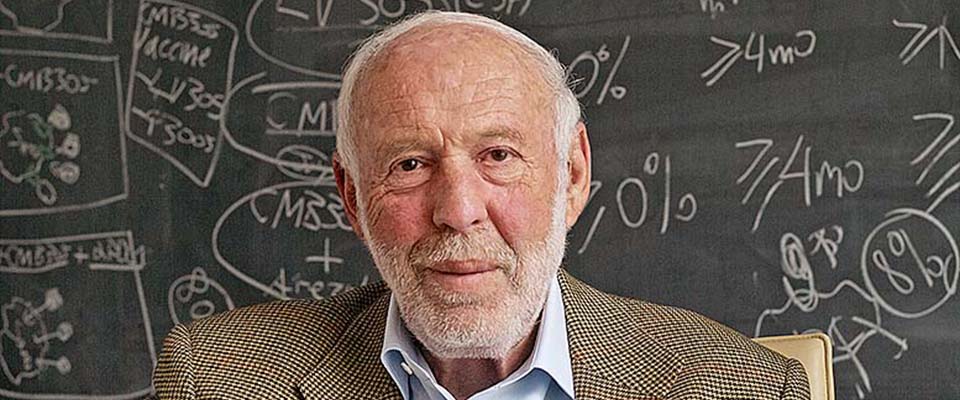As a teenager in Newton, Massachusetts, James Simons had a short-lived job in the basement stockroom of a garden supply store. “I was terrible at it; couldn’t remember where anything went,” he told an audience at Massachusetts Institute of Technology (MIT) in 2013. He was quickly demoted to floor sweeper, “Which I loved: It was easy, took no brain work.”
When his after-school job was over, the owners asked him what his plans for the future were, and he told them he wanted to study math at MIT. “They thought that was the funniest thing they ever heard. The guy who couldn’t remember where to put the sheep manure, he’s going to be a mathematician at MIT.”
This is not your average last-laugh story. Simons not only entered the prestigious university at the age of 17, in 1955, he finished the four-year program in three years before heading for UC Berkeley where he received his Ph.D. in mathematics in 1962 at the age of 23. A few years later, he was hired and then fired as a code cracker for the Pentagon’s secretive Institute for Defense Analysis (IDA) at Princeton. By 1968 he was chair of the math department at Stony Brook University, where he created one of the top geometry centers in the world. While there, he and Shiing-Shen Chern, who was at Berkeley, published what is now known as the Chern-Simons Invariant, which later had a huge influence on theoretical physics.
Simons left academia in 1978 to start what became Renaissance Technologies, an early pioneer in quantitative, or model-based, trading, primarily in commodities and currencies; the Medallion Fund he managed there is one of the world’s most successful hedge funds. Forbes has listed him among the top 100 richest people in the world, and he has been called “the world’s smartest billionaire.”
Simons didn’t seem to be listening. “In fact,” Patterson wrote, “it seemed as if Simons had dozed off in the middle of Andresen’s presentation … his Merit cigarette burning to a cinder in an ashtray before him.” When Andresen finished, Simons opened his eyes, lit another cigarette, and “proceeded to reel off every single one of Island’s major weaknesses.”
For the last seven years he has ostensibly been retired and now oversees the Simons Foundation, which has invested millions in math and science research and education, including groundbreaking work in the study of autism, and special projects such as Berkeley’s $60 million Simons Institute for the Theory of Computing.
Not bad for a guy who got bumped down to floor sweeper.
I met with Simons at his top-floor office in New York’s Flatiron District on a freezing day in February. He was in a collared shirt, no tie; loafers, no socks. At 77 he is white-haired and bearded and a bit stooped in his stance, but it would be a mistake to underestimate his acuity.
In Wall Street Journal reporter Scott Patterson’s book Dark Pools: High-Speed Traders, AI Bandits and the Threat to the Global Financial System, Patterson recalled a meeting Matt Andresen took with Simons in 2000. Andresen was in the middle of a well-rehearsed pitch for Island, a computerized trading hub, when it occurred to him that Simons didn’t seem to be listening. “In fact,” Patterson wrote, “it seemed as if Simons had dozed off in the middle of Andresen’s presentation … his Merit cigarette burning to a cinder in an ashtray before him.” When Andresen finished, Simons opened his eyes, lit another cigarette, and “proceeded to reel off every single one of Island’s major weaknesses.”
That dormouse routine may be more common in academia than in the chest-beating world of high finance, and Simons may be unusual in another way: He is self-deprecating about most of his achievements. He’ll tell you that many of his successes—turning the math department at Stony Brook around, making Medallion into a powerhouse fund—came from smart hires and sticking to his guns. Although other hedge funds now use the same kinds of computer models pioneered by Renaissance, they’re not consistent, he says. “You either slavishly follow the model, or it isn’t going to work very well,” he says. “We never overrode the model.”
In his personal life, Simons has not always stayed the course. Between degrees at MIT and Berkeley, Simons and some Colombian friends he had made at school undertook a motor scooter trip from Boston to Bogotá—his first trip out of the country. “It’s amazing that I returned intact, but I did,” he says. They rode through Mexico and Guatemala and Costa Rica on their Lambrettas, sometimes sleeping on the ground or even in the local jails of the little villages they passed through. “Everyone wanted to see the gringos who had done this crazy thing, so we were invited to all kinds of people’s houses,” he recalls. Some time after that scooter trip, the country became a catalyst for Simons’s business career when his friends there started manufacturing vinyl tile and plumbing, and he became an investor. Their company dovetailed with the construction boom in Colombia, and Simons profited from the association for many years to come.
He arrived in Berkeley in 1959, ostensibly to work with Chern, who, he learned upon arrival, had celebrated his first year at the University by taking a sabbatical. Simons’s fiancée, Barbara, had transferred from Wellesley to be with him, and the couple married and rented an apartment on Parker Street.
“Berkeley was still kind of a regular college town,” he recalls. “There were no drugs that I was ever offered. There was a lot of political activity always on campus; someone was always giving a speech about something, some horror that was occurring someplace that we should be aware of and do something about.”
Using $5,000 the couple had received as wedding gifts, Simons set out to invest in the stock market. After seeing some fairly ho-hum returns on his initial investment, he went to visit his Merrill Lynch broker in San Francisco and asked him where he could make some real money. “He said, ‘Yeah, soybean futures.’ I think I knew what soybeans were in principle, though I’d never seen one. He explained to me the mysteries of the futures market and said soybeans, which were then $2.50 a bushel, were going to shoot up to $3 or $3.50.”
Simons ignored the advice of a friend to sell immediately when soybeans spiked, and lost on the venture before going back in and recouping. “So I made that money back and a little bit [more], but I was running back and forth between Berkeley and San Francisco to watch the market open,” he says. “It was 7 o’clock in the morning, which seemed like the middle of the night to me. I thought, I’m either going to write a thesis or trade soybeans. I can’t do both.”

He finished and published his Ph.D. thesis in a prestigious journal before returning to the East Coast to do some teaching at MIT.
Simons began working at the Pentagon’s Institute for Defense Analysis in part because they paid and allowed mathematicians and scientists to work on their own projects in their spare time. Although not overtly political, Simons was appalled when his uber-boss, General Maxwell Taylor, wrote a story for The New York Times Magazine in 1967 talking about how great things were going in Vietnam.
“I thought it was a really stupid article, so I wrote The New York Times a letter saying not everyone who works for General Taylor agrees with his views, and I gave my views, which were different from those of General Taylor,” Simons says. “Nobody [at the IDA] said anything, but I was clearly on their watch list.”
Shortly thereafter, a stringer from Newsweek paid him a call, looking for defense department employees who were opposed to the war. Simons told him that he was only working on his own stuff until the war was over, as a sort of passive protest.
“That was sort of my policy, but I was exaggerating a little bit,” he says now. “I was kind of a wise guy.” He then told his boss what he had done, who in turn told Taylor, who in turn fired Simons. The 29-year-old math genius was stunned.
“My title,” he told his boss, “is Permanent Member of the Institute of Defense Analysis. How can you fire me?”
He was told, “The difference between a permanent member and a temporary member is that a temporary member has a contract.”
Though Simons says his objections to the war were more rational than emotional, the Domino Theory “just seemed absurd to me, and there were all these kids getting killed,” he recalls. “Because I had a child and I was a little bit older, I wasn’t going to get drafted. It just seemed a rotten business, so I spoke out against it.” His daughter, Liz, who along with her brother Nat later went to Berkeley, remembers being in summer camp where all the other kids got candy from home. “I was 10 and the Vietnam War was happening, and he and my mom sent me a whole bunch of peace necklaces,” she says.
Fresh from his ouster from IDA, Simons accepted the offer from Stony Brook University, which then had what he calls an excellent physics department but a terrible math department. “But they had a lot of money in those days and they wanted to build mathematics, and I thought that would be fun.”
And so Simons hired and fired his way to making a first-class math department. “I thought it was better to be a fire-er than a fire-ee,” he told the audience at MIT. But he quickly got bored and left academe, he says now. “I was also in between wives at that point. I didn’t know I was in between them, but I knew I was on the wrong side of the first one. But I met the woman who is now my wife,” Marilyn Simons, president of the foundation that bears their name.
Simons started an early fund with his Colombian friends, with whom he’d been in business, and discovered again how he disliked the vagaries of the stock market. “When you’re a fundamental trader,” he says, “one day you come into the office and everything has gone your way overnight—Oh boy, I’m a genius! And the next day you come in and everything has gone against you and it’s Oh, boy, I’m a dope. It’s kind of stomach-wrenching.” So he systematized his investments and turned to the world he had come from for his talent.
“We didn’t hire anyone who had worked on Wall Street before,” he says. “We hired people out of universities, national laboratories; people who were very good scientists but who wanted to try something different. And make more money if it worked out.”
To say it worked out would be an understatement. Working with the late algebraist James Ax, who earned his Ph.D. from Cal in 1961, Simons created the Medallion Fund, which was ultimately run entirely by employees. Medallion is “famed for having one of the best records in investing history,” according to a 2014 Bloomberg report, “returning more than 35% annualized over a 20-year span.” Renaissance Technologies, which inhabits a sprawling, secretive campus on Long Island, had roughly $65 billion worth of assets under management in 2015, and the people working there have been called “the best math-physics department in the world.”
“He likes to put things in that kind of humorous way, but he’s always cared deeply about the world and people,” says Liz. “When I was growing up he made sure we all understood the importance of thinking about other people, other people’s experiences.”
While the company is “still going great guns,” according to Simons, he is not there anymore. “I’m the chair, and I own shares in the company, but I don’t run it.” In 1994 he and Marilyn started the Simons Foundation. Seven years ago he retired from business to work with the foundation, “and I’ve never been so busy in my life.”
When I ask if there had been some sea change that prompted the move, Simons laughs and says, “Yes, the sea change was I had some money. You can’t give much charity unless you have some money to give.”
“He likes to put things in that kind of humorous way, but he’s always cared deeply about the world and people,” says Liz. “When I was growing up he made sure we all understood the importance of thinking about other people, other people’s experiences.” She recalls wandering the streets of Bogotá with him when she was 13. “There was poverty I hadn’t seen before, and he talked to me about it and what it was like to live there, and it made me think about it deeply.”
Today, with her husband, Mark Heising, Liz runs the Heising-Simons Foundation (the couple met when they were undergrads at Cal). She says some of her interest in early math education, which the foundation supports, stems from her childhood, when math games were what they did on car trips, instead of singing “99 Bottles of Beer on the Wall.”
Liz also believes the death of two of her brothers had a profound effect on her father’s decision to devote his life to philanthropy. In 1996, his son Paul was killed bicycling on Long Island, at the age of 34; in 2003, Nicholas, who had been doing volunteer work in Katmandu, drowned at age 24. “It definitely got him interested in thinking through the eyes of his sons: What would they have liked to do in the world,” says Liz.
James and Marilyn started the Nick Simons Institute to train medical workers in Nepal in his name. (“Nick really had his eyes opened working there and said at one point to my parents that he felt working in third-world countries was his life,” says Liz.) They also opened the Avalon Park and Preserve to the public on Long Island to honor Paul’s interest in the outdoors.
For all Simons’s slightly curmudgeonly affect, he clearly values compassion and generosity, but his life and its three acts—math, business, philanthropy—seem as much guided by curiosity as anything. The research funded by the Simons Foundation is not outcome oriented, per se; yes, they would like to find a treatment for autism. And they would like to see the math skills of students across the country improve thanks to the foundation’s innovative Math for America program (which has proven very successful in NYC public schools, in part by augmenting the salaries of teachers who qualify). But he doesn’t fixate on the outcome; when your life has taken the kinds of turns his has, why would he?
He points to the framed Chern-Simons equation that hangs on his wall—pure Greek to me. (I was relieved when I saw him interviewed at a TED Talk in 2015, and TED curator Chris Anderson asked if Simons could explain the equation. “No,” he responded. “I could explain it to somebody. But not many people!”)
“It’s good math,” he says. “But about ten years after, the physicists picked it up and it now has a lot of influence in physics, in string theory and condensed matter, practical physics. I didn’t know any physics; I still don’t know any physics…. So who knew that the math would apply to physics?”
He offers the example of Isidor Rabi, the Nobel laureate who discovered nuclear magnetic resonance, the science behind magnetic resonance imaging. Several other scientists built on that discovery (winning several Nobels in the process) before the theory found its use in technology.
“All of that took about 50 years,” says Simons. “Finally, it turns out Rabi, who was a young man when he discovered this first principle, had an MRI and said he could never have imagined that what he did would lead to this medical machine that would image his elbow or whatever it was that needed an image.
“That’s the thing about basic science: You never know where it’s going to go.”
Sean Elder is a contributing writer at Newsweek and coauthor, with Amos Kamil, of Great Is the Truth: Secrecy, Scandal and the Quest for Justice at the Horace Mann School (Farrar, Straus and Giroux, 2015).





















